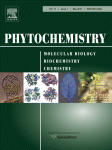Ver ítem
- xmlui.general.dspace_homeCentros Regionales y EEAsCentro Regional MisionesEEA Cerro AzulArtículos científicosxmlui.ArtifactBrowser.ItemViewer.trail
- Inicio
- Centros Regionales y EEAs
- Centro Regional Misiones
- EEA Cerro Azul
- Artículos científicos
- Ver ítem
Metabolic classification of South American Ilex species by NMR-based metabolomics
Resumen
The genus Ilex to which mate (Ilex paraguariensis) belongs, consists of more than 500 species. A wide range of metabolites including saponins and phenylpropanoids has been reported from Ilex species. However, despite the previous works on the Ilex metabolites, the metabolic similarities between species which can be used for chemotaxonomy of the species are not clear yet. In this study, nuclear magnetic resonance (NMR) spectroscopy-based metabolomics was
[ver mas...]
The genus Ilex to which mate (Ilex paraguariensis) belongs, consists of more than 500 species. A wide range of metabolites including saponins and phenylpropanoids has been reported from Ilex species. However, despite the previous works on the Ilex metabolites, the metabolic similarities between species which can be used for chemotaxonomy of the species are not clear yet. In this study, nuclear magnetic resonance (NMR) spectroscopy-based metabolomics was applied to the classification of 11 South American Ilex species, namely, Ilex argentina, Ilex brasiliensis, Ilex brevicuspis, Ilex dumosa var. dumosa, I. dumosa var. guaranina, Ilex integerrima, Ilex microdonta, I. paraguariensis var. paraguariensis, Ilex pseudobuxus, Ilex taubertiana, and Ilex theezans. 1H NMR combined with principal component analysis (PCA), partial least square-discriminant analysis (PLS-DA) and hierarchical cluster analysis (HCA) showed a clear separation between species and resulted in four groups based on metabolomic similarities. The signal congestion of 1H NMR spectra was overcome by the implementation of two-dimensional (2D)-J-resolved and heteronuclear single quantum coherence (HSQC). From the results obtained by 1D- and 2D-NMR-based metabolomics it was concluded that species included in group A (I. paraguariensis) were metabolically characterized by a higher amount of xanthines, and phenolics including phenylpropanoids and flavonoids; group B (I. dumosa var. dumosa and I. dumosa var. guaranina) with oleanane type saponins; group C (I. brasiliensis, I. integerrima, I. pseudobuxus and I. theezans) with arbutin and dicaffeoylquinic acids, and group D (I. argentina, I. brevicuspis, I. microdonta and I. taubertiana) with the highest level of ursane-type saponins. Clear metabolomic discrimination of Ilex species and varieties in this study makes the chemotaxonomic classification of Ilex species possible.
[Cerrar]

Autor
Kim, Hye Kyong;
Saifullah;
Khan, Saifullah A.Jamil;
Wilson, Erica Georgina;
Prat Kricun, Sergio;
Meissner, Axel;
Göraler, Sibel;
Deelder, André Martien;
Choi, Young-hae;
Verpoorte, Robert;
Fuente
Phytochemistry 71 (7) : 773-784 (May 2010)
Fecha
2010-05
Editorial
Elsevier
ISSN
0031-9422
1873-3700
1873-3700
Formato
pdf
Tipo de documento
artículo
Palabras Claves
Derechos de acceso
Restringido
 Excepto donde se diga explicitamente, este item se publica bajo la siguiente descripción: Creative Commons Attribution-NonCommercial-ShareAlike 2.5 Unported (CC BY-NC-SA 2.5)
Excepto donde se diga explicitamente, este item se publica bajo la siguiente descripción: Creative Commons Attribution-NonCommercial-ShareAlike 2.5 Unported (CC BY-NC-SA 2.5)

